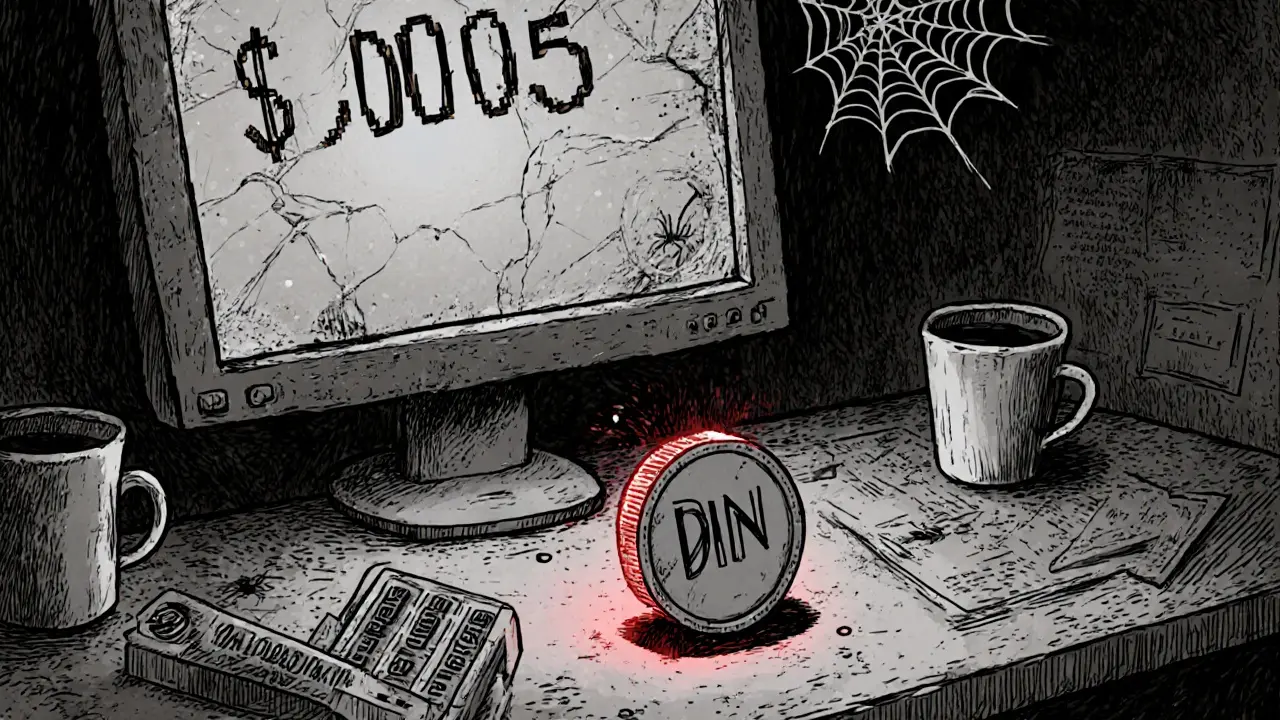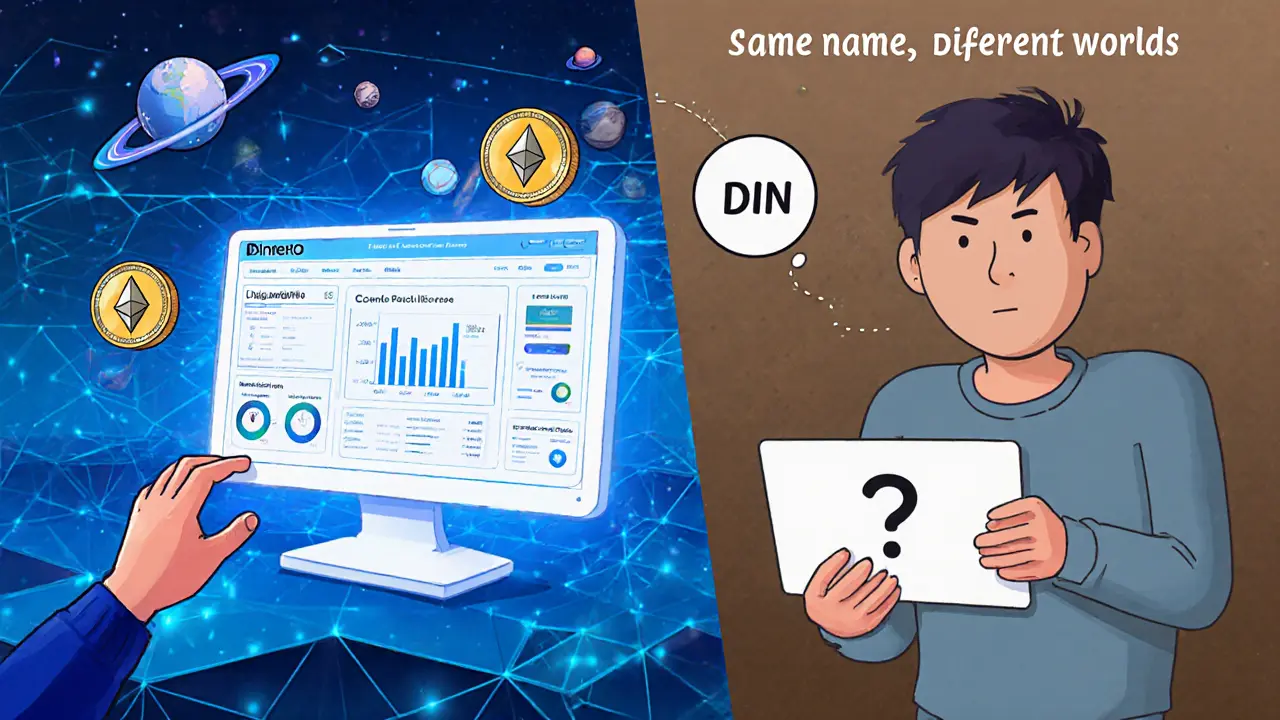Dinero Coin Comparison Tool
Which Dinero Are You Researching?
Confusing these two projects could cost you. This tool clarifies the critical differences between the two Dinero projects.
DINERO (Stablecoin)
Yield-bearing stablecoin for Ethereum DeFi
50% ETH + 50% pxETH (staked ETH)
Earnings from Ethereum staking
Available on Uniswap, SushiSwap
- Earns yield while holding stablecoin
- Directly integrates with Ethereum DeFi protocols
- Backed by real ETH staking assets
- Active development and institutional focus
DIN (Mineable Token)
Privacy-focused coin
No tangible backing
None
$13 daily volume (near-zero)
- Minimal liquidity - hard to trade
- No active development or team
- Price: ~$0.000565 (2025)
- Highly speculative - no real utility
Your Research Guide
Select a Dinero project to see key research considerations.
There’s more than one Dinero in crypto-and confusing them could cost you. When you search for "Dinero (DINERO)" online, you’re not just looking at one coin. You’re stepping into a tangled web of two very different projects that share a name but little else. One is a high-tech stablecoin built for DeFi pros. The other is a low-volume mineable token promising privacy payments. If you’re trying to understand what Dinero is, you need to know which one you’re talking about.
The Dinero Stablecoin: A DeFi Asset Built on ETH
The most significant Dinero project is DINERO, a stablecoin created by Redacted Cartel, a well-known group in decentralized finance. Unlike most stablecoins that peg to the U.S. dollar using cash reserves or algorithmic tricks, DINERO is backed by a mix of Ethereum (ETH) and pxETH-the liquid staking token from Pirex Finance. This means every DINERO token is tied to real ETH locked in Ethereum’s proof-of-stake system, not just bank deposits.
Here’s how it works: Redacted Cartel uses a dual-reserve system. Half of the collateral is ETH, the other half is pxETH. pxETH earns yield from Ethereum staking, and that yield gets funneled back into the DINERO protocol. This isn’t just a passive backing-it’s an active engine that generates income. The protocol then uses that income to maintain the $1 peg, even when markets get wild.
What makes DINERO different? It’s not just a stablecoin. It’s designed to be a yield-bearing asset. While you hold DINERO, you’re indirectly earning from Ethereum staking rewards. That’s rare. Most stablecoins like USDC or DAI don’t pay you anything. DINERO does. And because it’s built on Ethereum, it can plug into other DeFi protocols-lending, borrowing, liquidity pools-without needing bridges or wrappers.
Redacted Cartel also added USDC to the reserve mix to smooth out price spikes. If demand for DINERO surges, USDC can be sold to meet demand without forcing ETH sales. This keeps the price stable and reduces pressure on the underlying collateral.
The Dinero Mineable Token: DIN, the Privacy Coin That Almost No One Trades
Then there’s DIN. It’s not related to the Dinero stablecoin. It’s a completely separate project, hosted at dinerocoin.org, and it’s built to be a privacy-focused digital currency. The team behind DIN claims it’s "based on Bitcoin and Dash," aiming to offer fast, anonymous transactions. Think Monero or Zcash-but without the brand recognition or developer activity.
As of November 2025, DIN trades at around $0.000565. It has a total supply of 100 million coins, with about 8.9 million in circulation. That sounds like a lot, but the daily trading volume is barely over $13. That’s not a market. That’s a hobby project. There’s no major exchange listing it. No institutional interest. No liquidity. You can mine it, sure-but mining DIN won’t pay your rent.
Unlike DINERO, which is a DeFi product with real technical infrastructure, DIN has no clear roadmap. No active development updates. No team disclosures. No partnerships. It exists as a token on a few decentralized exchanges, mostly for speculative trading. If you’re looking for a privacy coin, Monero (XMR) or Zcash (ZEC) are proven, battle-tested options. DIN is a gamble with no upside.
Dinero.xyz: The Yield Engine Behind the Scenes
Behind DINERO is another piece of the puzzle: Dinero.xyz. This isn’t a coin. It’s a suite of DeFi tools designed to maximize yield from Ethereum staking. The core product here is pxETH, the liquid staking token that powers DINERO’s collateral. pxETH lets users stake ETH and get a tokenized version that can be used in DeFi while still earning staking rewards.
Redacted Cartel uses pxETH as the backbone of DINERO’s collateral because it’s one of the highest-yielding liquid staking solutions on Ethereum. That’s not marketing fluff-it’s technical fact. pxETH earns more than basic ETH staking because it’s layered with additional DeFi strategies, like lending and liquidity provision, all managed by Redacted Cartel’s governance.
Dinero.xyz isn’t targeting casual users. It’s aimed at institutions, large wallets, and yield hunters who want to squeeze every last percentage point out of their ETH. That’s why DINERO exists: it’s not just a stablecoin. It’s a gateway to institutional-grade staking yields wrapped in a dollar-pegged asset.

What’s Next for Dinero (DINERO)?
Redacted Cartel isn’t sitting still. They’re building meta-transaction infrastructure that will let users pay gas fees in DINERO or other tokens instead of ETH. Right now, using DINERO still requires ETH for network fees. That’s a friction point. Once this feature rolls out, DINERO becomes truly self-sufficient within its ecosystem.
They’re also working on private transactions-something no other ETH-based stablecoin offers. Imagine sending DINERO without anyone seeing the amount or the addresses involved. That could make it attractive for institutional users who need privacy but still want regulatory compliance.
And because DINERO is tied to Redacted Cartel’s broader ecosystem, improvements here ripple out. Better DINERO performance means higher value for Btrfly, another token in their network. That creates a feedback loop: stronger collateral, more demand, more yield, more adoption.
Where to Buy Dinero (DINERO) and DIN
If you want DINERO, you’ll need to go to decentralized exchanges like Uniswap or SushiSwap. It’s not listed on Coinbase, Binance, or Crypto.com. That’s a red flag for casual traders-but not for DeFi natives. You’ll need a wallet like MetaMask, some ETH for gas, and a basic understanding of how to swap tokens on a DEX.
DIN is even harder to find. You might see it on obscure DEXs like Uniswap or PancakeSwap, but trading it is risky. With $13 in daily volume, you could easily get stuck. No one’s buying or selling. Liquidity is almost nonexistent.

Should You Invest in Dinero?
It depends on what you’re looking for.
If you’re into DeFi and want a stablecoin that earns yield-without leaving Ethereum-DINERO is worth exploring. It’s not as liquid as USDC, but it’s more innovative. It’s not for everyone, but for those who understand collateralized yield systems, it’s a compelling option.
If you’re looking for a privacy coin to use for anonymous payments, skip DIN. It’s not dead, but it’s not alive either. No development. No community. No future. Monero or Zcash are far better choices.
And if you’re just chasing the name "Dinero" because it sounds cool? Walk away. Crypto is full of copycats. This isn’t one of them-it’s two projects sharing a name, and only one has real substance.
Final Take
Dinero isn’t one coin. It’s two. One is a sophisticated DeFi stablecoin built on Ethereum, backed by real staking yield, and tied to a serious team with a roadmap. The other is a low-volume mining token with no traction, no updates, and no future. If you’re researching Dinero, you need to ask: Are you interested in yield, or anonymity? Because these projects serve completely different worlds.
Stick with DINERO if you’re a DeFi user. Avoid DIN unless you’re speculating on dead coins. And always check the contract address before buying. Names can trick you. Technology doesn’t lie.

DINERO is fascinating because it doesn’t just peg to USD-it actively grows from ETH staking yields. That’s not just innovation, it’s redefining what a stablecoin can be. Most people think stablecoins are dead assets, but this one’s alive with DeFi energy.
Oh my god, I just spent 45 minutes reading this and I’m still shaking. DINERO is like if Bitcoin had a baby with a hedge fund and raised it on Ethereum staking rewards. Meanwhile DIN? That’s the crypto equivalent of a ghost town with a sign that says ‘Welcome to the Future’-but no one’s home.
So let me get this straight-you’re telling me there’s a coin called DINERO that actually earns yield, and another called DIN that’s basically a crypto ghost story? I’m not surprised. The crypto world is just a Shakespearean tragedy with more wallets.
Everyone’s acting like DINERO is some genius invention but it’s just another DeFi rug with a fancy name. pxETH? Redacted Cartel? Sounds like a cult with a whitepaper. And DIN? At least it’s honest about being useless. You people worship anything that says ‘yield’ like it’s holy water
The structural elegance of DINERO lies in its dual-reserve architecture-ETH as hard collateral, pxETH as yield-generating asset, and USDC as a volatility buffer. This isn’t just a stablecoin; it’s a macroeconomic instrument wrapped in smart contract logic. DIN, by contrast, is a semantic echo with zero systemic value.
I didn’t know DINERO existed until today. Now I’m hooked. If you’re into DeFi and don’t have some DINERO in your wallet, you’re sleeping on one of the smartest moves in crypto right now.
Wait… so you’re telling me this ‘DINERO’ stablecoin is backed by pxETH-which is itself a DeFi layer on top of staked ETH-which means you’re basically stacking yield on yield on yield? That’s not finance. That’s financial incest.
I read this whole thing and now I feel like I’ve been gaslit by blockchain. DINERO sounds like a billionaire’s pet project and DIN is what happens when someone names their crypto after a Spanish word for money and then forgets to build anything. I’m just here for the drama
Redacted Cartel? pxETH? You think this isn’t a centralized entity masquerading as decentralized? They control the collateral, the yield, the roadmap-this isn’t crypto, it’s a hedge fund with a blockchain costume. And DIN? At least it’s decentralized in the truest sense: no one cares.
Thank you for clearly separating these two. I’ve seen so many people mix them up and I’ve been afraid to speak up in case I sounded dumb. This was exactly the clarity I needed.
DINERO is the future of yield-bearing stablecoins-period. The fact that it’s built on Ethereum and integrates with pxETH means it’s not just a token, it’s a gateway to institutional-grade DeFi. If you’re not positioned here, you’re already behind.
so like… dinero is good? and din is like… a meme? i think i get it? but also i’m confused bc why do they both have the same name?? like who thought that was a good idea?? 🤦♀️
Can someone explain what pxETH is again? I know it’s from Pirex but I’m still fuzzy on how it earns more than regular ETH staking. Is it just lending it out or something?
I really appreciate how this breaks down the two projects. Too many people jump into crypto because of the name and end up losing money. This is the kind of clear, calm breakdown we need more of.
Reading this made me realize how much I’ve been missing out on DeFi. I thought stablecoins were just for moving money between exchanges. Now I see they can actually grow your holdings. I’m going to dig deeper into DINERO.
So if DINERO earns yield from ETH staking, does that mean holding it is kind of like staking ETH without locking it up? That’s wild. I’ve been holding USDC just to avoid volatility-this might be the upgrade I’ve been waiting for.
Excellent breakdown. The distinction between DINERO and DIN is critical. One is a sophisticated financial instrument; the other is a cautionary tale. Always verify contract addresses. Names lie. Code doesn’t.
Let me be perfectly clear: the fact that DINERO is built on Ethereum and uses pxETH as collateral isn’t innovation-it’s consolidation of power. Redacted Cartel controls the collateral, the yield mechanism, and the governance. This isn’t decentralized finance. It’s centralized finance with a blockchain veneer. And DIN? At least it’s transparently useless. No illusions. No promises. Just a token with no future and no buyers. That’s honesty.
Meanwhile, DINERO’s users are being sold a dream: ‘You’re earning yield!’ But what happens when ETH staking rewards drop? When pxETH’s DeFi strategies underperform? When the USDC buffer is exhausted? The protocol’s stability is a house of cards built on assumptions, not guarantees.
You think this is better than USDC? USDC is backed by audited reserves. DINERO is backed by speculative yield engines. One is a bank. The other is a hedge fund masquerading as money.
And don’t get me started on the private transactions they’re ‘working on.’ If they’re building privacy into a token that’s already on Ethereum-a public ledger-they’re either delusional or lying. Privacy on Ethereum? That’s like building a vault inside a glass house.
They’re not building for users. They’re building for the next round of funding. For VCs who want to sell their tokens after the next bull run. The roadmap? It’s not a roadmap. It’s a sales pitch.
And yet, people are buying it. Because ‘yield’ sounds better than ‘risk.’ Because ‘DeFi’ sounds smarter than ‘banking.’ Because they don’t want to admit they’re gambling.
DINERO isn’t the future. It’s the latest iteration of crypto’s oldest trick: packaging volatility as safety. And DIN? It’s the quiet, honest reminder that not everything with a name deserves your attention.
So yes, go ahead and buy DINERO if you want. But don’t call it innovation. Call it ambition. And call DIN what it is: the crypto equivalent of a graveyard with a sign that says ‘Future Home of a Great Idea.’
Wow. I just read this and I feel like I’ve been slowly dying inside. I thought I understood crypto. Turns out I just understood the surface. DINERO feels like the only thing here with a soul. And DIN? It’s like finding a forgotten USB drive labeled ‘crypto dreams’ in your ex’s attic.
One sentence: DINERO is the only stablecoin that actually works for you, not against you.